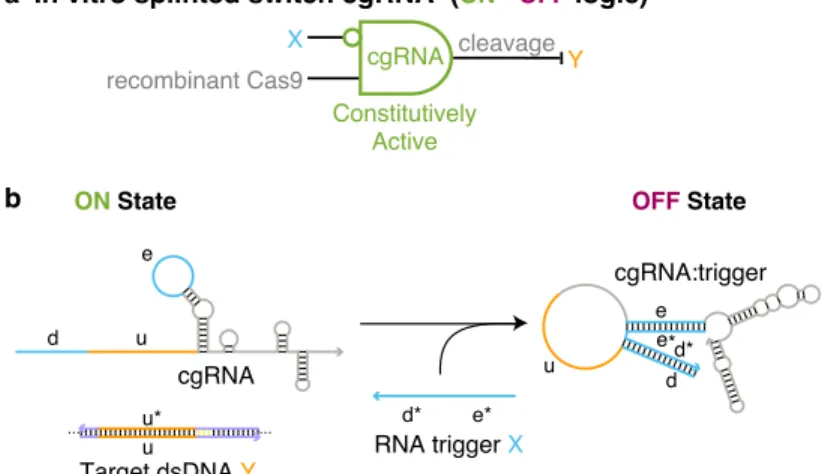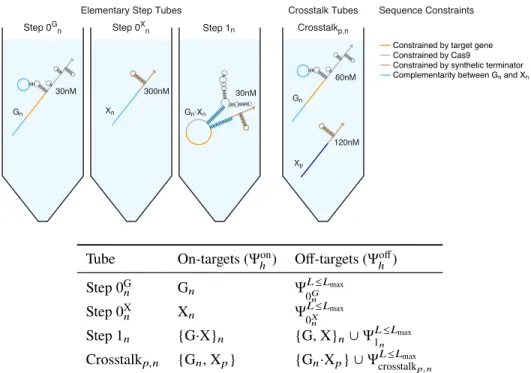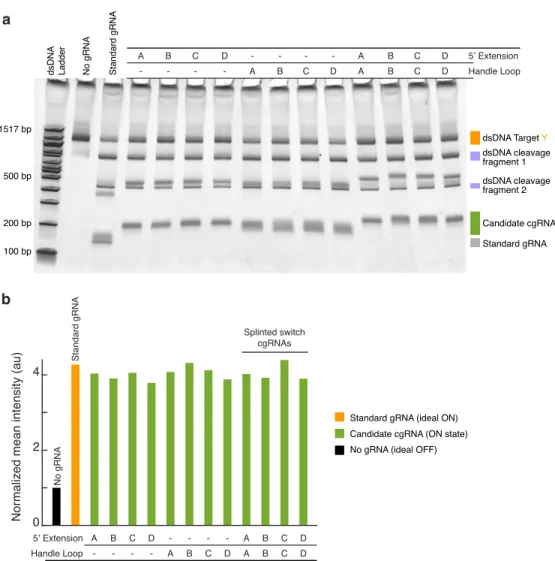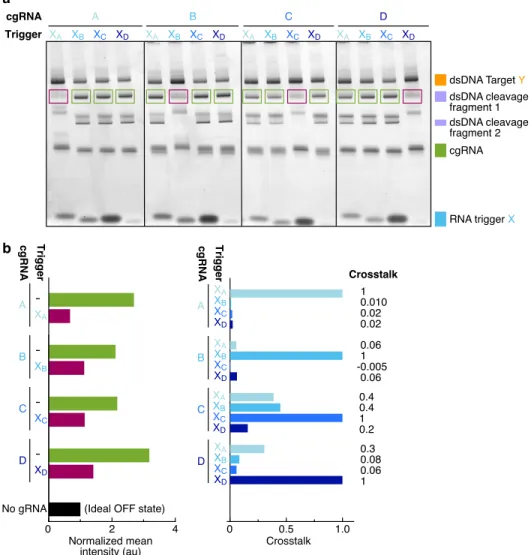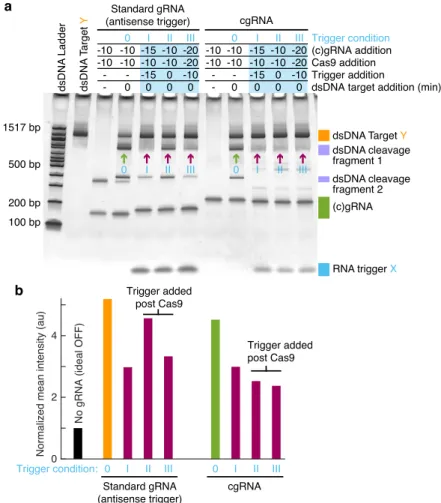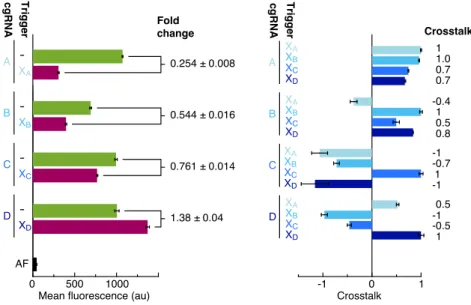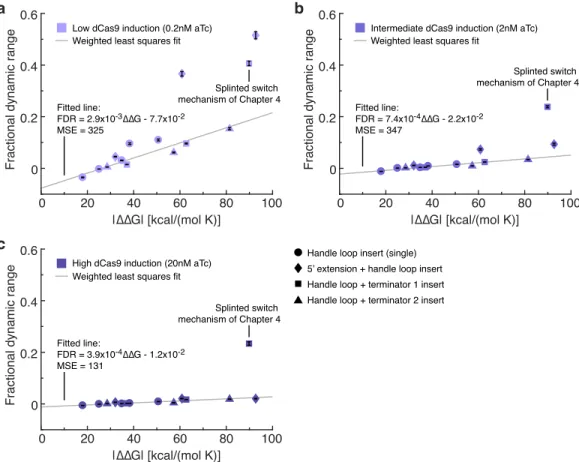Using an in vitro assay for cgRNA activity with synthetic trigger, in vitro transcribed cgRNA and recombinant dCas9, we observe a conditioned (ON→OFF logic) response for a set of four allosteric constitutively active cgRNAs with a median ≈6% cross-talk between non-cognate cgRNA/trigger pairs. For each mechanism, automated sequence design is performed using the pathway designer in NUPACK to produce an orthogonal library of cgRNAs that respond to different RNA triggers.
INTRODUCTION
- Nucleic acid nanotechnology through the rational design of sequence and structurestructure
- Programmable regulation with CRISPR/Cas
- Conditional guide RNAs
- Thesis outline
Prior to our laboratory's work on cgRNA engineering, there were no reports in the literature of a systematic study of the sequence and structural changes of a standard gRNA required to switch CRISPR/Cas activity (ON→OFF or OFF→ON) in response to trigger nucleic acid hybridization. A systematic study of the sequence and structural requirements for a functional guide RNA also gives us insight into the structural components of gRNA that are most sensitive to perturbation and, as such, the design of the guide mechanism to achieve the desired OFF state.
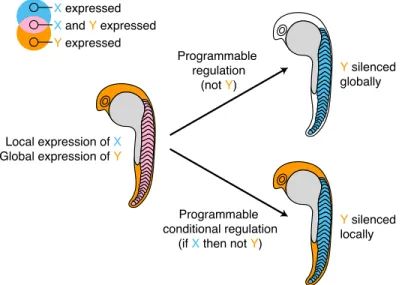
ENGINEERING ORTHOGONAL CONSTITUTIVELY ACTIVE cgRNAS IN VITRO VIA HYBRIDIZATION OF TARGET
SEQUENCE-INDEPENDENT MODIFICATIONS
An in vitro assay of cgRNA activity in the absence and presence of the same promoter produced a marked shift in the cgRNA band at a 2x (Figure B.2) and 10x (Figure 2.5a) excess, indicating the formation of cgRNA: duplex trigger as intended. When an antisense promoter of the short target binding site was annealed with a standard gRNA before the addition of Cas9 (Figure 2.6a, the standard gRNA promoter.
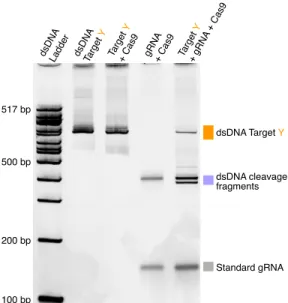
STUDY OF DOMAIN DIMENSIONING FOR CONSTITUTIVELY ACTIVE SEQUENCE-INDEPENDENT cgRNAS IN E. COLI
The example on-target structures depicted above correspond to the 15 nt handle loop insertion candidate cgRNA. 5' extension/handle loop splice switch High dCas9 induction (20nM aTc) Intermediate dCas9 induction (2nM aTc).
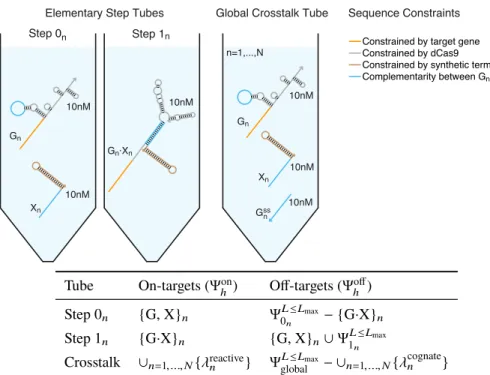
ENGINEERING ORTHOGONAL CONSTITUTIVELY ACTIVE cgRNAS IN E. COLI VIA HYBRIDIZATION OF TARGET
Automated sequence design of orthogonal constitutively active splinted switch cgRNAs using NUPACKswitch cgRNAs using NUPACK
To simultaneously design N orthogonal systems, elementary stage tubes are specified for each system (Figure 4.3; left). For the selected design experiment, the predicted structural defects depicted in Figure 4.4 (cgRNA A, trigger XA) are typical - on-target complexes are predicted to form in quantitative yield at the target concentrations, but with some unintended base pairing (nucleotides not in dark red). Examining the library of three orthogonal splinted switch-cgRNA/trigger pairs (Figure 4.7b; left), we observe a median≈15-fold ON→OFF conditioned response with the expression of the cognate trigger.
With a paired expression of each cgRNA (A, B and C) with each trigger (XA, XB and XC) (Figure 4.7b; right), we observe high selectivity for the respective trigger for the conditioned response of each cgRNA, with average crossover of ≈2% between unrelated cgRNA/trigger combinations.
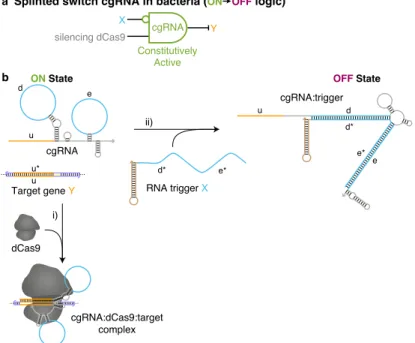
Increasing fractional dynamic range of splinted switch cgRNAs
Comparison of the cgRNA AF state with the ideal AF state of the gene target gRNA control (Figure 4.7a), however, indicates an obvious potential for improvement, namely improving the performance of the cgRNA AF state and thus the fractional dynamic range of the splint switching mechanism. A potential way to improve the performance of the cgRNA OFF state and the corresponding fractional dynamic range with no change to the cgRNA itself (i.e., using the same cgRNA/trigger sequence) is dCas9 loading competition. The competition had a differential effect on OFF and strictly ON-state fluorescence, resulting in an increase in the fractional dynamic range with increased competitor expression (Figure 4.8d), although at the expense of the ON-state performance .
Examination of standard gRNA controls (ideal ON) and no-target gRNA (ideal OFF) controls reveals that the observed increase in partial dynamic range is due in part to a reduction in ideal dynamic range; however, most of the increase is actually due to an increase in the absolute dynamic range with increased expression of the off-target gRNA competitor.
Characterization of cgRNA temporal response with induction of cognate triggertrigger
Gain insight into the temporal response of cgRNAs to trigger expression and confirm the trigger dependence of the observed conditional ON → OFF response in one E. At low trigger induction ([IPTG] = 0), comparable fluorescence is observed for a strain carrying a constitutive cgRNA + lacI-regulated trigger expression plasmid and for the strain with constitutive cgRNA expression only (Figure 4.9b). With increasing trigger induction, we observe no significant change in fluorescence for the cgRNA-only strain (ON state), but a monotonically increasing fluorescence for the cgRNA + lacI-regulated trigger strain, confirming that the magnitude of the conditioned response depends on trigger expression, and the cgRNA behaves , as planned.
Subtraction of the mean normalized fluorescence of uninduced cgRNA + pLac trigger from each induction time course (Figure 4.9d) reveals the time-resolved dependence of the conditional response on induction of a cognate trigger, yielding a significant increase in ∆ (Fluorescence/A600). perceived. 1–2 hours after trigger induction.
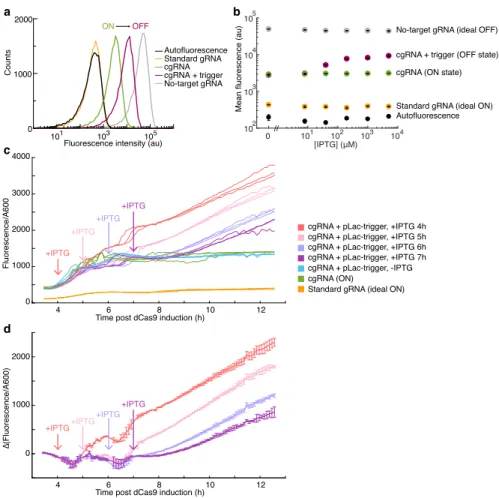
ENGINEERING ORTHOGONAL CONSTITUTIVELY INACTIVE cgRNAS IN E. COLI VIA SEQUESTRATION OF THE TARGET
BINDING REGION
For a library of three orthogonal cgRNA/trigger pairs with toehold switch, we observe a median ≈3-fold OFF → ON conditional response to the expression of the cognate trigger and median crosstalk of ≈20% between non-cognate cgRNA/trigger combinations. In an effort to improve the performance of the toehold switching mechanism, we investigated the effect of related trigger domain length on the activity of the cgRNA ON state. As expected, we observed a significant increase in fluorescence upon expression of the cognate trigger lacking the strand displacement domain (that is, the hybridization support domain alone is insufficient to produce the observed OFF → ON conditional response; cgRNA A + 0 nt stem trigger, figure 5.5A).
Truncation of the toehold domain by only three nucleotides (cgRNA A + 12 nt toehold trigger, Figure 5.5b) results in a significant loss of cgRNA function, while a 5 nt extension of both trigger and cgRNA toehold (cgRNA A-20 + 20 nt) toehold trigger) does not provide better than 15 nt toe hold.
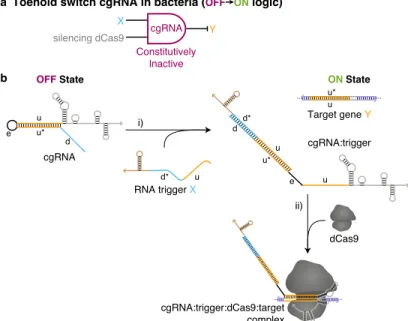
CONCLUSIONS AND FUTURE DIRECTIONS
- Developing cgRNA mechanisms with improved dynamic range
- Detection of endogenous mRNA inputs with cgRNAs
- Mechanism engineering for versatile constitutively inactive (OFF → ON) cgRNAscgRNAs
- Future applications for cgRNAs
Development of new cgRNA mechanisms and/or refinement of the sequence design process is also merited in the pursuit of cgRNA mechanisms with improved performance. The significant sequence restriction of the trigger binding domains (constrained to be complementary to a window of the endogenous trigger sequence) poses a challenge for cgRNA sequencing; relaxing the general constraint on the design by allowing the target binding region to be selected from a library of contiguous PAM sequences within the target gene may be useful. The incompatibility with future applications of interest and the relatively poor performance of the footswitch mechanism motivates the development of a different basic inactive mechanism.
The goals of sequence independence and mobility (ie, dissociation from trigger) of the ON state of an OFF→ON cgRNA could be achieved by the logical inversion of an ON→OFF cgRNA.
BIBLIOGRAPHY
Shen, Z. et al. Conditional knockouts generated by engineered CRISPR-Cas9 endonuclease reveal the roles of coronin in C. Ma, H. et al. Multiplexed labeling of genomic loci with dCas9 and engineered sgRNAs using CRISPRainbow.Nat. Dang, Y. et al. Optimizing sgRNA structure to improve CRISPR-Cas9 knockout efficiency. Genome Biol.
Cencic, R. et al. Protospacer Adjacent Motif (PAM)-distal sequences involve CRISPR Cas9 DNA Target Cleavage.PLOS ONE9,e.
MATERIALS AND METHODS
Rational design of libraries of orthogonal cgRNAs using NUPACK For each mechanism, orthogonal cgRNA/trigger pairs were designed using the reac-For each mechanism, orthogonal cgRNA/trigger pairs were designed using the reac-
Watson–Crick Constraints: The cgRNA sequence domains “d” and “e” are constrained to be the complementary domains of the trigger sequence “d*” and “e*”. Pattern Prevention Restrictions: The following patterns are prevented for cgRNA sequence domains “d” and “e”: AAAA, CCCC, GGGG, UUUU.
In vitro assay of gRNA/cgRNA activity with catalytically active Cas9 Sequences for parts used in in vitro studies are provided in Section A.4
Methods for bacterial studies in E. coli
The upper bound on the estimated standard error applies under the assumption that the correlation between SIG and AF is non-negative. The upper limit of the estimated standard error applies under the assumption that the correlation between the SIG in the two strains is non-negative. The upper limit of estimated standard error applies under the assumption that the correlation between SIG+AF in the two strains is non-negative.
The upper bound on estimated standard error applies under the assumption that the correlation between strains is non-negative.
Part sequences for cgRNA, trigger, and control gRNA
1 AATAGGCGTATCACGAGGCAGAATTTCAGATAAAAAAAATCCTTAGCTTTCGCTAAGGATGATTTCTGGAATTCTAAAGATCTTTGACGGCTAGCTCAGTCCTAGGTACAGTGCTAGCAACTTTCAGTTTAGCGGTCTTAATACAACGAACATAAAAAAAAGGATCAAGAAGATCCTTTGG>>>>>>>>>>>>>>>>>>>>>>>>>>>>>>>>>>>>>>>>>>>>>>>>>>>>>>>>>>>>>>> >>>> >>>>>>>>>>>>>>>>>>>>>>>>>>>>>>>> >>>>>>>>>>>>>>>>>>>>>>>>>>>>>>>>>>>>>>>>>>>>>>>>>>>>>>>>>>>>>>>>>>>> >> EcoRI BglII BBa_J23100 mRFP målspecifik spacer BBa_B0050 >>>>>>>>>>>>>>>>> de novo sequence d* 201 GAACAAAAACTCATCTCAGAAGAGGATCTGAATAGCGCCGTCGACCATCATCATCATCATCACCATCCATCCATCATTGATTTTAGTAGGATTGATTGATCATTGAGTTTTAGACGT CAGATTAAATCAGAAC GCAGAAGCGGTCTGATAAAACAGAATTTGCCTGGCGGCAGTAGCGCGGTGGTCCCACCT 400 401 GACCCCATGCCGAACTCAGAAGTGAAACGCCGTAGCGCCGATGGTAGTGTGGGGTCCCCATGCGAGAGTAGGGAACTGCCAGGCATCAAAAACGTCCGTCCGTCCGTCCGT ACTGGATCTCTGACAGCTAGCTCAGTCAGTCCT AGGTATAATGCTAGCATGT 600 >>>>>>>>>>> > >>>>>>>>>>>>>>>>>>>>>>>>>>>>>>>>>> Scar BBa_J23108 de novo sekvens d 601 TCGTTGTATTAAGACCGCTAAACTGAAAGTTACACGCCCAACTTTCAGTTTAGCGGTCTGTTTTAGAGCTAGGAGATTAGGTCAAGTAACTACC TTTTTTTTGAAGCTTGG GCCCGAACAAAAACTCATCTCAGAAGAGGATCTGAATAGCGCCGTCGAC 800 >>>>>> >> >>> >>>>>>>>>>>>>>>>>>>>>.
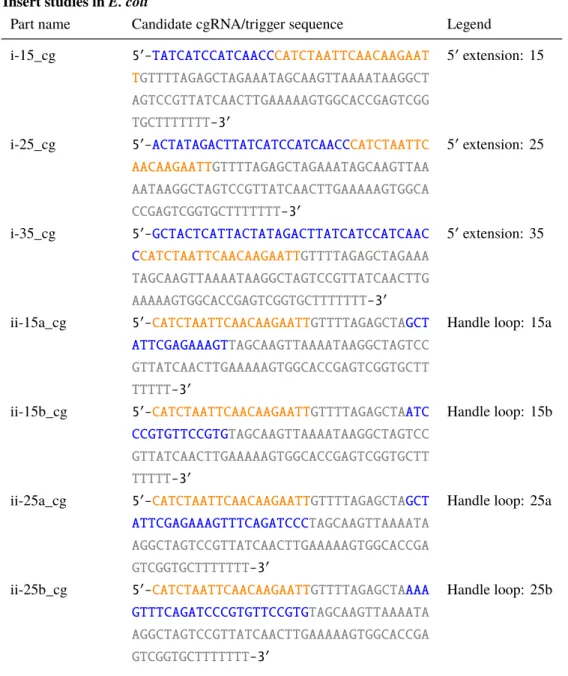
SUPPLEMENTARY FIGURES AND DATA FOR CHAPTER 2
Magenta boxes were used for quantification of mean pixel intensity of signal + background for Figure 2.5b, orange boxes were used for quantification of mean pixel intensity of subtracted background.
SUPPLEMENTARY FIGURES AND DATA FOR CHAPTER 3
Mean ± estimated standard error (with propagation of uncertainty) based on the mean fluorescence of a single cell over 20,000 cells for each of N = 3 replicate wells. Mean ± estimated standard error (with uncertainty propagation) based on the mean single cell fluorescence over 20,000 cells for each of N = 3 replicate wells. The fractional dynamic range is higher for cgRNA:trigger pairs with high |∆∆G|, but becomes smaller with increased dCas9 induction.
Fitted lines calculated using least-squares regression weighted by the inverse of the variance estimate of the mean.118.
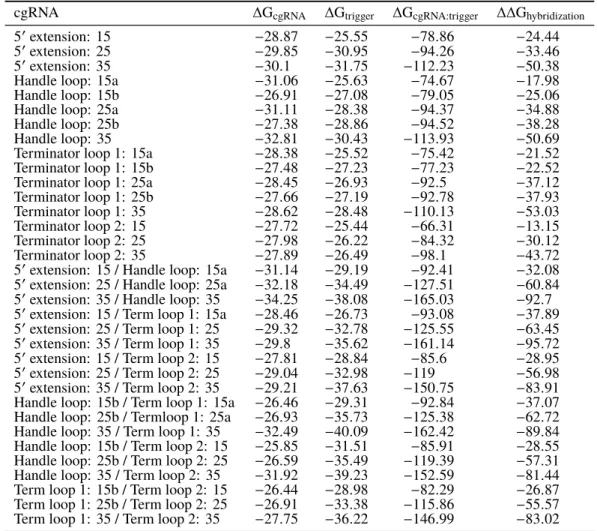
SUPPLEMENTARY FIGURES AND DATA FOR CHAPTER 4
Expression of RNA trigger X switches the cgRNA from ON→OFF, leading to an increase in fluorescence. Mean±estimated standard error (with uncertainty propagation) based on the mean single-cell fluorescence over 20,000 cells for each of N = 3 replicate wells. Induced expression (aTc) of silencing dCas9 and constitutive expression of sfGFP target gene Y and either: standard gRNA, cgRNA without trigger, cgRNA + cognate trigger or cgRNA + a non-cognate trigger.
Expression of the cognate RNA trigger (XAfor cgRNA A, XBfor cgRNA B, XCfor cgRNA C) switches the cgRNA from ON→OFF, leading to an increase in fluorescence.
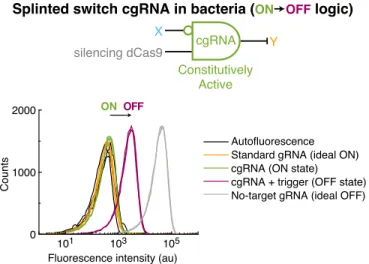
SUPPLEMENTARY FIGURES AND DATA FOR CHAPTER 5
